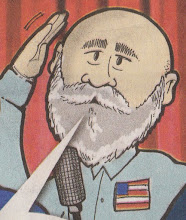I am spending the summer as a Park Ranger at Gettysburg National Military Park, PA where I make presentations to the public and answer questions at the Visitor Center. It’s the best job I ever had and I am loving every minute of it.
But today I almost died of laughter.
Sitting in the Interpretive preparation area of the new Visitor Center with Rangers Dan Welch and Liz Dietzen I was working on my Battle Overview Powerpoint presentation. Dan was reading “Command and Communication Frictions in the Gettysburg Campaign” by Phillip M. Cole. As I walked by him, knowing my background in the Marine Corps, he said, “Whenever two Marines are together, one is in charge.”
Kind of surprised at the comment I agreed and he continued, “Really, it’s right here in this book.” He then started paging through the book looking for the quote and eventually found it on page 9. Then like any good researcher we went to the footnote to find the source. I waited patiently for him to find the footnote, which read, “. . . Glenn B. Knight, editor and compiler, Unofficial Dictionary for Marines [Internet Address: http://4merMarine.com/USMC/dictionary.html copyright 2002-2005].” Yes, the source was me.
The dictionary got its start as a 12-word glossary for members of my Yahoo group, MyMarine. The group is for parents, relatives and friends of Marine Corps Recruits—we help them to get through the often mysterious 13-week roller-coaster ride that is Marine Corps Boot Camp. It can be found at http://groups.yahoo.com/group/mymarine/.
The Unofficial Dictionary for Marines is just exactly that. It is FOR Marines and it comes with a warning that the information contained within it is not politically correct, is sometimes obscent and somethimes even borders on the pornographic—but is is the lexicon used by Marines from 1775 to yesterday. Please don’t check it out if you are easilly offended.
Marines love it. Others think it is just in bad taste. I’ve enjoyed collecting it, verifying it and publishing it.


